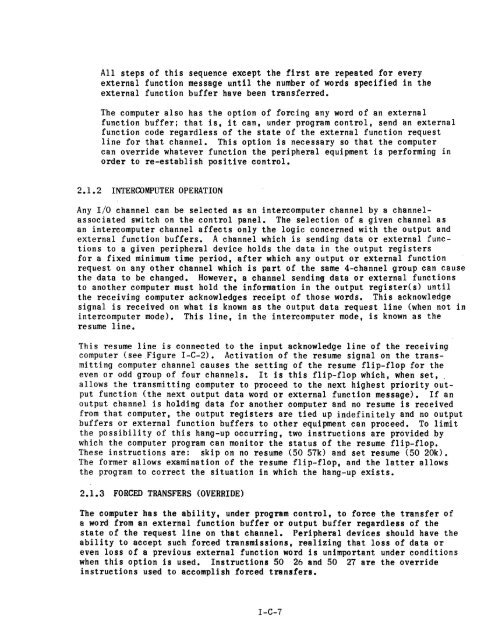U UNIVAC 1218 - Bitsavers
U UNIVAC 1218 - Bitsavers
U UNIVAC 1218 - Bitsavers
Create successful ePaper yourself
Turn your PDF publications into a flip-book with our unique Google optimized e-Paper software.
All steps of this sequence except the first are repeated for every<br />
external function message until the number of words specified in the<br />
external function buffer have been transferred.<br />
The computer also has the option of forcing any word of an external<br />
function buffer; that is, it can, under program control, send an external<br />
function code regardless of the state of the external function request<br />
line for that channel. This option is necessary so that the computer<br />
can override whatever function the peripheral equipment is performing in<br />
order to re-establish positive control.<br />
2.1.2 INTERCOMPUTER OPERATION<br />
Any I/O channel can be selected as an intercomputer channel by a channelassociated<br />
switch on the control panel. The selection of a given channel as<br />
an intercomputer channel affects only the logic concerned with the output and<br />
external function buffers. A channel which is sending data or external functions<br />
to a given peripheral device holds the data in the output registers<br />
for a fixed minimum time period, after which any output or external function<br />
request on any other channel which is part of the same 4-channel group can cause<br />
the data to be changed. However, a channel sending data or external functions<br />
to another computer must hold the information in the output register(s) until<br />
the receiving computer acknowledges receipt of those words. This acknowledge<br />
signal is received on what is known as the output data request line (when not in<br />
intercomputer mode). This line, in the intercomputer mode, is known as the<br />
resume line.<br />
This resume line is connected to the input acknowledge line of the receIvIng<br />
computer (see .Figure I-C-2). Activation of the resume signal on the transmitting<br />
computer channel causes the setting of the resume flip-flop for the<br />
even or odd group of four channels. It is this flip-flop whichv when set, .<br />
allows the transmitting computer to proceed to the next highest priority output<br />
function (the next output data word or external function message). If an<br />
output channel is holding data for another computer and no resume is received<br />
from that computer, the output registers are tied up indefinitely and no output<br />
buffers or external function buffers to other equipment can proceed. To limit<br />
the possibility of this hang-up occurring, two instructions are provided by<br />
which the computer program can monitor the status of the resume flip-flop.<br />
These instructions are: skip on no resume (50 57k) and set resume (50 20k).<br />
The former allows examination of the resume flip-flop, and the latter allows<br />
the program to correct the situation in which the hang-up exists.<br />
2.1.3 FORCED TRANSFERS (OVERRIDE)<br />
The computer has the ability, under program control, to force the transfer of<br />
a word from an external function buffer or output buffer regardless of the<br />
state of the request line on that channel. Peripheral devices should have the<br />
ability to accept such forced transmissions, realizing that loss of data or<br />
even loss of a previous external function word is unimportant under conditions<br />
when this option is used. Instructions 50 26 and 50 27 are the override<br />
instructions used to accomplish forced transfers.<br />
I-C-7
















